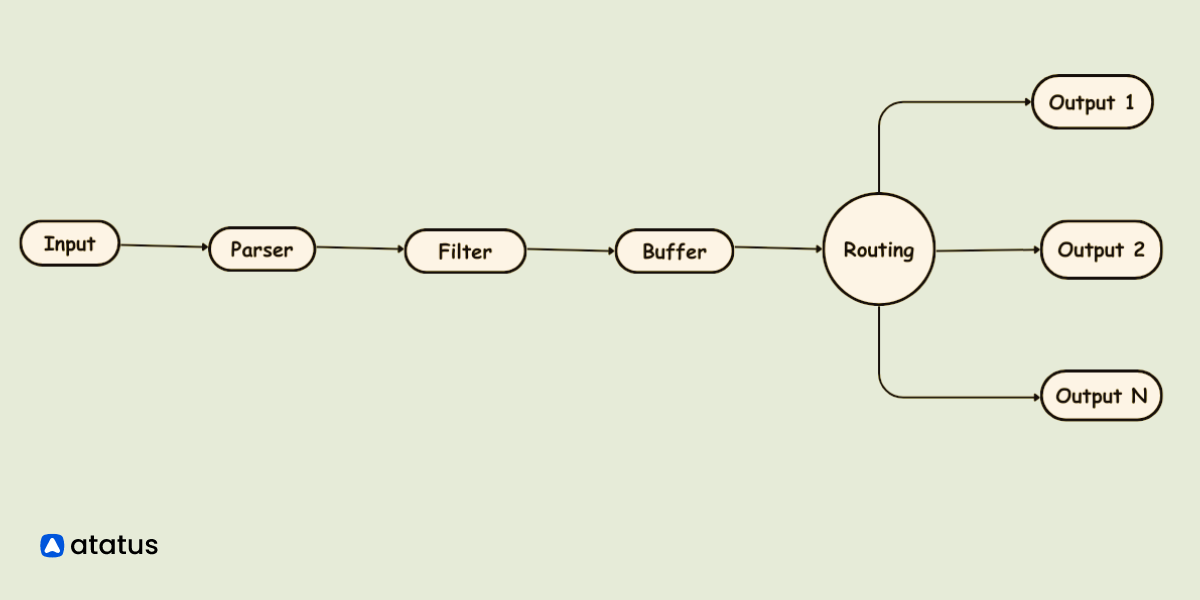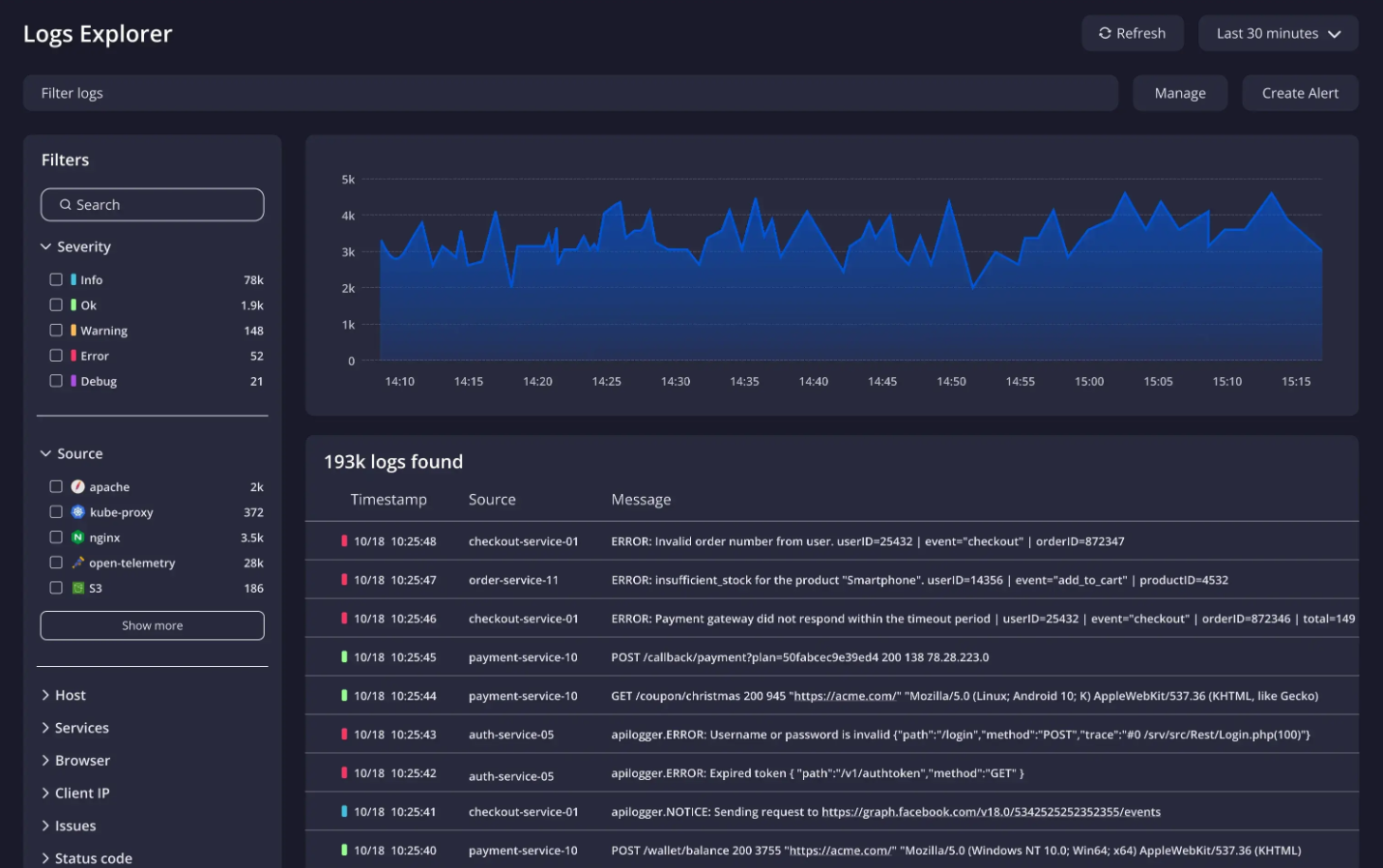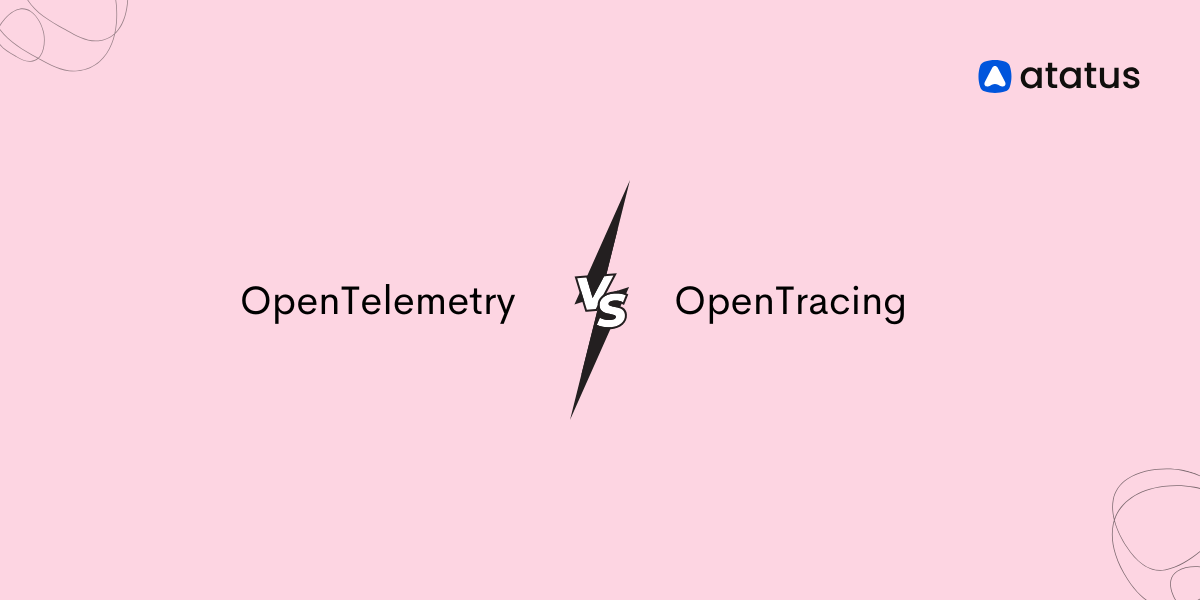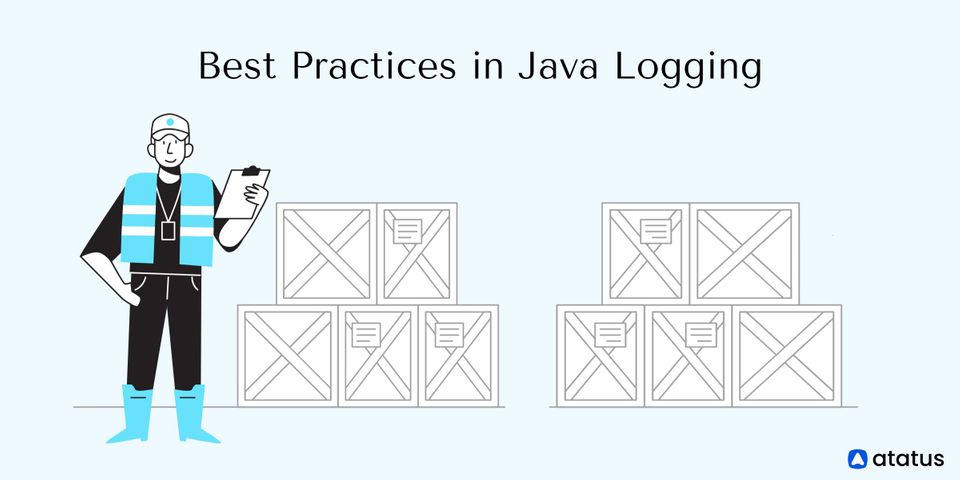Fluentd vs Fluent Bit: A Side-by-Side Comparison 2025
Fluentd and Fluent Bit are both open-source data collection and processing tools, but they serve different purposes. Fluentd offers a comprehensive, plugin-rich architecture ideal for centralized log aggregation. Fluent Bit is designed for performance and efficiency, making it a better fit for edge devices and environments with limited resources. This Fluentd vs Fluent Bit comparison outlines their key differences, helping you decide which fits your infrastructure best.
Table of Contents:
- Fluentd vs Fluent Bit: An Overview
- Fluentd vs Fluent Bit: Architecture
- What are the key differences between Fluentd and Fluent Bit?
- Fluentd and Fluent Bit similarities
- Fluentd vs Fluent Bit: Use Cases
- Choosing Between Fluentd and Fluent Bit
- Centralized Log Management with Atatus
- FAQs
Fluentd vs Fluent Bit: An Overview
Fluentd is an open-source data collection tool built for centralized log aggregation and processing. It supports a wide range of data sources and outputs through its extensive plugin system, and formats logs in JSON for structured, machine-readable output. Fluentd is ideal for building advanced log pipelines in high-scale environments.
Fluent Bit is a lightweight, high-performance log forwarder and telemetry agent designed for edge computing, IoT, and containerized environments like Kubernetes. It’s optimized for minimal resource usage and can collect, parse, and ship logs from resource-constrained systems to central logging backends efficiently.
Fluentd vs Fluent Bit: Architecture
Fluentd Architecture
Fluentd follows a modular architecture where each component, Input, Parser, Filter, Buffer, and Output works independently and can be customized through plugins. This design offers flexibility for building complex log pipelines with advanced processing and routing.
Fluent Bit Architecture
Fluent Bit uses a lightweight, high-performance architecture, with its core components, Input, Parser, Filter, and Output compiled directly into the binary. This compact design reduces overhead and improves efficiency, making it ideal for edge and containerized environments.

What are the key differences between Fluentd and Fluent Bit?
1. Programming Language and Architecture
- Fluentd is primarily developed in Ruby, with performance-critical components written in C.
- Fluent Bit is implemented entirely in C, enabling higher performance and lower memory usage.
The underlying language impacts extensibility, execution speed, and deployment.
2. Resource Consumption
- Fluentd generally consumes 30–40 MB of memory or more, depending on plugin usage.
- Fluent Bit typically uses less than 1 MB of memory, making it well-suited for systems with limited resources.
Fluent Bit is optimized for minimal resource overhead, making it ideal for embedded, edge, and containerized environments.
3. Scalability
- Fluentd is designed for high-throughput, centralized log processing across large-scale distributed systems.
- Fluent Bit supports horizontal scaling through lightweight deployment across multiple nodes and can be configured to forward logs upstream for further processing.
4. Plugin Ecosystem
- Fluentd offers an extensive plugin ecosystem with over 1,000 community and official plugins, allowing for advanced input, transformation, and output capabilities.
- Fluent Bit includes a focused set of performance-optimized core plugins, covering the most common log collection and forwarding requirements.
5. Performance and Efficiency
- Fluentd offers feature-rich processing but incurs higher CPU and memory usage, making it better suited for centralized systems where resource availability is not a constraint.
- Fluent Bit is optimized for low-latency, high-throughput environments where performance and efficiency are critical.
6. Primary Use Case
- Fluentd is ideal for centralized log aggregation, where advanced filtering, enrichment, and routing are required.
- Fluent Bit is preferred for lightweight log forwarding, particularly in Kubernetes, IoT, and edge environments.
7. Architectural Design
- Fluentd follows a modular plugin-based architecture:
Input → Parser → Filter → Buffer → Output
This enables complex pipeline configurations and custom transformations. - Fluent Bit implements a similar but more streamlined flow:
Input → Parser → Filter → Output
All components are compiled into the binary for maximum performance and portability.
8. Deployment Models
- Fluentd is typically deployed as a central log processor, either as a standalone service or in cloud-native environments.
- Fluent Bit is commonly deployed as a Kubernetes DaemonSet, or on edge devices, where minimal resource consumption is essential.
Here’s a quick differences of these tools:
| Aspect | Fluentd | Fluent Bit |
|---|---|---|
| Design Philosophy | Complete log management system. | A lightweight and efficient telemetry agent and forwarder. |
| Resource Usage | Greater memory footprint and increased resource requirements. | It is optimized for minimum resource utilization and a smaller memory footprint. |
| Use Cases | Centralized log handling in more expansive systems. | Resource-limited situations, edge computing, and the Internet of Things. |
| Plug-in Ecosystem | A broad, well-developed ecosystem with various inputs, filters, and outputs. | A comprehensive suite of plugins emphasizing efficiency and specialized use cases. |
| Flexibility vs. Features | Provides increased flexibility through full log processing features. | Has a lower feature count and places more emphasis on efficiency and simplicity. |
| Integration | Often, a stand-alone log management system that interfaces with other systems to provide analysis. | Often used as a forwarder to transmit logs into Fluentd or other centralized systems. |
| Configuration | Due to the various functionality and setting possibilities, the learning curve may be longer. | has a lighter, more straightforward configuration that is intended for rapid integration. |
| Scalability | Excellent for more thorough customization required for large-scale deployments. | Fast integration; effective functioning in resource-constrained contexts. |
| Scope | Containers/Servers | Embedded Linux / Containers / Servers |
| Language | C & Ruby | C |
| Memory | > 60 MB | ~ 1 MB |
| Performance | medium | High |
| Dependencies | It takes a specific quantity of gems to build as a Ruby Gem. | No dependencies unless a particular plugin calls for them. |
| Plugins | The number of possible external plugins exceeds 1000. | The number of integrated plugins is over 100. |
| License | Apache License v2.0 | Apache License v2.0 |
Fluentd and Fluent Bit similarities
- Released under the provisions of the Apache Licence, Version 2.0.
- Graduated Hosted projects by the Cloud Native Computing Foundation (CNCF)
- Production-grade solutions: millions of times a day, deployed.
- Community-driven and vendor-neutral projects
- Widely Accepted by the Industry: all significant businesses, including Microsoft, Google Cloud, AWS, and hundreds more, rely on it.
Fluentd vs Fluent Bit: Use Cases
Fluentd
- Financial Services
Used in banks and fintech platforms to collect logs from multiple applications and databases, enrich them with contextual metadata, and forward to centralized storage for compliance audits, fraud detection, and regulatory reporting. - E-Commerce Platforms
Deployed in high-traffic commerce applications (e.g., order processing, payment gateways) to correlate logs across microservices and infrastructure layers, enabling real-time observability and incident investigation. - Telecommunications
Used to collect and unify logs from distributed telecom systems (e.g., VoIP, mobile infrastructure, customer portals), supporting performance monitoring and customer experience management. - Kubernetes Clusters
Integrated as the central log processor in Kubernetes environments, often paired with Fluent Bit at the node level, to aggregate, transform, and route logs to platforms like Elasticsearch, Kafka, or cloud logging services. - Security Operations Centers (SOC)
Fluentd is used to ingest logs from various sources (e.g., firewalls, intrusion detection systems, endpoint agents), normalize and structure them, and forward to SIEM platforms for security analysis and threat detection.
Fluent Bit
- IoT Deployments
Used on IoT gateways and devices (e.g., smart meters, sensors, industrial machines) to capture telemetry and log data, apply basic filtering or enrichment, and forward to cloud systems for centralized processing. - Cloud Infrastructure
Widely adopted in cloud-native environments such as AWS EKS, GCP GKE, and Azure AKS. Deployed as a DaemonSet to collect logs from pods and nodes, process locally, and forward to observability stacks like Loki, Fluentd, or cloud-native tools. - Retail and Point-of-Sale (POS) Systems
Installed on POS terminals and edge computing devices in retail stores to forward application and transaction logs securely to central systems for monitoring, auditing, and fraud detection. - Content Delivery Networks (CDNs)
Used within edge servers in CDN infrastructures to collect access logs and metrics from distributed nodes and stream them to central logging pipelines with minimal latency and overhead. - Managed Hosting & SaaS Platforms
Embedded in hosting platforms and multi-tenant SaaS systems to capture tenant-specific logs, tag them with identifiers, and forward to appropriate logging backends for isolated monitoring and billing.
Choosing Between Fluentd and Fluent Bit
While Fluentd and Fluent Bit serve similar purposes in log collection and forwarding, the right choice depends on your deployment context, resource availability, and processing complexity.
Choose Fluent Bit when:
- You need a lightweight log forwarder for edge devices, IoT, or Kubernetes nodes.
- You are operating in resource-constrained environments and require minimal memory and CPU usage.
- Your goal is to collect and forward logs efficiently to a central system with limited or no local processing.
- You want to deploy an agent-based logging solution that runs as a Kubernetes DaemonSet, forwarding logs from each node.
Choose Fluentd when:
- You require advanced log processing, including enrichment, buffering, multi-destination routing, and custom transformations.
- You are working with complex or high-volume log pipelines that demand flexibility and extensibility.
- Your architecture requires integration with a wide range of outputs, supported by Fluentd’s extensive plugin ecosystem.
Combined Usage: Fluent Bit and Fluentd
In distributed systems, particularly in cloud-native and Kubernetes environments, a common pattern is to use Fluent Bit as the lightweight forwarder and Fluentd as the centralized aggregator.
Fluent Bit runs on the edge (e.g., as a DaemonSet in Kubernetes), responsible for log collection and initial filtering.
Fluentd receives data centrally, handling complex parsing, transformation, routing, and integration with observability or storage platforms.
This combined approach mirrors the relationship between Beats and Logstash, where one handles lightweight log shipping and the other manages heavy processing.
Centralized Log Management with Atatus
Once logs are collected and forwarded, whether by Fluent Bit or Fluentd, you need a robust, centralized platform to store, analyze, and visualize that data. That’s where Atatus fits in.

Atatus provides a unified observability platform for logs monitoring, offering:
- Real-time search and filtering across distributed logs
- Rich visualizations and dashboards
- Correlation with metrics and traces for full-stack observability
- Alerting and anomaly detection based on log patterns
By integrating Fluent Bit and Fluentd with Atatus, teams can build an end-to-end logging pipeline, from lightweight collection at the source to deep analysis and alerting in a centralized interface.
Try Atatus free for 14 days, monitor logs in real time and gain full visibility instantly.
FAQs:
What are Fluentd and Fluent Bit?
- Fluentd is a log processor that collects, enhances, and routes log data to various storage backends. It’s designed for centralized log management with extensive customization and plugin support.
- Fluent Bit is a lightweight log forwarder built for edge environments and systems with limited resources, focusing on efficient log collection and minimal system impact.
How are Fluentd and Fluent Bit related?
They are both part of the Fluent ecosystem and governed by the CNCF. Fluent Bit is a performance-optimized, minimal-footprint version of Fluentd, created to maintain essential logging functions while using fewer resources.
Can Fluentd and Fluent Bit be used together?
Yes, Fluentd and Fluent Bit can be used together in a complementary setup. A common pattern involves using Fluent Bit at the log source (e.g., servers, containers, edge devices) to collect and forward logs efficiently with minimal resource usage. These logs are then sent to Fluentd, which acts as the central log processor responsible for enrichment, transformation, filtering, and routing the data to various storage or analysis backends. This combination provides both high performance and flexibility in log management.
Which is better: Fluentd or Fluent Bit?
It depends on your requirements:
- Choose Fluentd for centralized log processing with advanced features like enrichment and routing.
- Choose Fluent Bit when you need efficient, lightweight log forwarding at the edge.
Is Fluent Bit suitable for Kubernetes?
Absolutely. Fluent Bit is ideal for Kubernetes setups and is commonly deployed as a DaemonSet to gather logs from all pods and forward them to a central logging destination like Fluentd or Loki.
Which tool is better suited for Kubernetes environments?
While both tools can be used, Fluent Bit is generally preferred in Kubernetes due to its lightweight design, lower resource usage, and native container support, making it ideal for dynamic, containerized workloads.
How do Fluentd and Fluent Bit handle data loss prevention?
Fluentd uses persistent buffers and retries to ensure reliable log delivery.
Fluent Bit supports in-memory and file buffering but requires careful tuning to avoid data loss under load.
Does Fluent Bit support log enrichment?
Fluent Bit supports basic enrichment, such as adding metadata and labels. For advanced transformations, Fluentd is the preferred choice.
What languages are Fluentd and Fluent Bit written in?
Fluentd is developed in Ruby, with critical components written in C. Fluent Bit is written entirely in C, resulting in lower memory usage and faster execution.
What are some alternatives to Fluentd and Fluent Bit?
Common alternatives include:
- Logstash – A flexible and powerful log processor
- Graylog – A centralized logging platform
- Atatus – Offers log monitoring with APM and error tracking in one platform.
- Promtail – Pairs with Grafana Loki for log aggregation
Can Fluentd and Fluent Bit integrate with Grafana and OpenTelemetry?
Yes, Fluent Bit integrates with Grafana Loki for log visualization. Fluentd supports OpenTelemetry, making it suitable for unified observability across logs, metrics, and traces.
How do I decide which tool to deploy?
Consider your environment and needs:
- Use Fluent Bit for edge computing or when system resources are limited.
- Use Fluentd if your log pipeline needs complex transformations, filtering, and routing.
Are there any hidden costs with Fluentd or Fluent Bit?
Both are free and open-source. However, Fluentd may consume more memory and CPU, and you should account for infrastructure costs like storage and bandwidth when deploying either tool.
What are the common challenges with Fluentd and Fluent Bit?
Fluentd may consume high memory, especially when using plugins like in_tail. Whereas Fluent Bit can drop logs if buffer limits are reached and not properly tuned.
Can Fluent Bit handle logs in JSON format?
Yes, Fluent Bit can efficiently parse, process, and forward structured JSON logs, making it compatible with modern logging standards.
#1 Solution for Logs, Traces & Metrics
APM
Kubernetes
Logs
Synthetics
RUM
Serverless
Security
More





